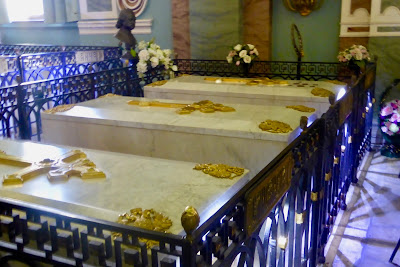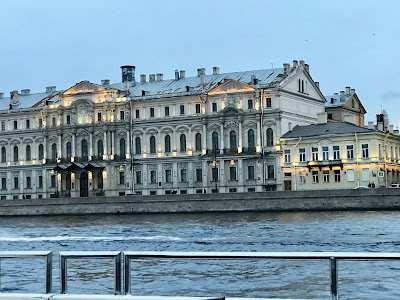 |
| The Hermitage from the water |
 |
| Mosaic portrait of Catherine the Great, The Hermitage. |
the comparatively narrow Small Hermitage, the New Hermitage, the large (old) Hermitage) and the Winter Palace of Peter I and Hermitage Theatre across the Winter Canal.
Most tours skim the highlights in the first three which requires going up stairs from ground level.
Tip: There are no observable elevators. I noticed a stair-chair but the crowds would make it next to impossible to use. With landings, there are 93 shallow steps.
You will see - or try to - Field Marshall Hall, Memorial Hall of Peter the Great,
a bit of Russian culture, French art from the 15th to 18th century,
some of the palace interiors, a very nice Gainesborough,
the famous Peacock Clock (it is turned on once a week; check with the Hermitage website, hermitagemuseum.org),
 a grand collection of Rembrandts,
a grand collection of Rembrandts,
a pair of DaVincis,
two Raphaels, Titians, the Knight's Hall, a Michelangelo sculpture (Catherine wasn't fond of sculpture),
an immense 1 A.D. Roman Jupiter, some lush Rubenses plus thousands of works that deserve to be studied but won't be.
 |
| The Hermitage from Palace Square. |
Tip: Between leaving the exhibits and retrieving your coat you will negotiate 109 stair steps.
 |
| General Staff building. Impressionists wing is on the left. |
Prepare to be amazed for the collection is a stunner. Russian businessmen were among the first to buy the Impressionists and the Hermitage collection is a revelation of their early work.
Imagine a room full of Monets,
 | |
| "Woman in the Garden" |
 |
| "Women of Arles" |
 |
| "Nave, Nave, Moe - Sacred Spring (Sweet Dreams)" |
 |
| "View of Collioure |
I went on an early Saturday morning in October and had many rooms of the General Staff building almost to myself.
 |
| The entrance of the General Staff building is surprisingly modern. |
When it comes to the Hermitage complex, accept that you will never see it all.
As the say about that immense treasure trove, it would take 12 years to spend one minute before each work on display.
The Faberge Museum is easier to take in. Its palace, the Shuvalov, is much smaller, the crowds thinner.
The art is sumptuous from the famed Romanov Easter eggs
to traditional Russian enamels
and much in between you had no idea the Faberge studios created.
Attention to detail is exquisite in the objects and their surroundings. Even the bathrooms are elegant.
Tip: The grand staircase up to the exhibits consists of 28 shallow steps.
Two churches were on my list.
Church of the Spilled Blood (Church of the Resurrection) is both an artistic and historical gem as it incorporates the site of the assassination of Emperor Alexander II.
 |
| Church is built atop assassination site. |
 |
| Blood-spattered railing and cobblestones from embankment where Nicholas II was shot. |
Inside it is a marvel of mosaics, 308 of them, that cover the walls.
They represent the artistry of over 25 artists; 42 of them, including Christ the Pantocrator of the central dome and the Eucharist, are the work of Nikolai Kharlamov.
 |
| Christ the Pantocrator mosaic. |
Outside a carnival atmosphere surrounds the edifice, with costumed characters, vendors and ever-present crowds.
Warning: Don't take a photo of the characters unless you are willing to tip them.
The Sts. Peter and Paul Cathedral is the center of The Peter and Paul Fortress, literally where Peter the Great began St. Petersburg on Hare Island. The bastions came first, but when the church was built it was the tallest building in Russia. The angel atop the spire is both weather vane and guardian of the city.
The cathedral is the imperial burial vault, beginning with the tomb of Peter the Great. All Emperors and Grand Dukes lie under identical white sarcophagi except for Alexander II and his wife Mari Alexandrovna. She was born a princess and they occupy colored jasper sarcophagi mined in the Urals in gratitude for abolition of serfdom.
In 1998 the remains of Nicholas II, the last Russian emperor, his family and their servants were buried in the cathedral's St. Catherine Chapel.
Tip: Steps at either cathedral are negligible but prepare for cobblestones at Peter and Paul Fortress.
St. Isaac's Cathedral, the fourth largest domed cathedral of its type in the world, was intended to be the greatest in Russia. It well might be, but it was cold with spitting rain, I was cathedraled out and the fireplace in the clubby bar at the Four Seasons across the square was far more tempting than the hulking St. Isaac's.
St. Nicholas Cathedral beckoned throughout my stay but there was never time to see more than its exterior en route to someplace else.
Palaces
 |
| The royal double eagles top Peterhof Palace. |
 |
| Grand Cascade at Peterhof, unfortunately with the fountains turned off for the winter. |
 |
| Peterhof ballroom |
 | |
| The throne... |
 |
| ...sat under the equestrian portrait of Catherine II, "the Great." |
 |
| Peterhoff formal dining room |
Warning: Check the Peterhof website for dates the fountains are turned off for winter, usually October through April or May. Arrive early to avoid the worst of the crowds and stay the day if you can. Bus tours used by river cruise lines tend to arrive too late and leave too early.
Catherine's Palace at Starskoye Selo is a gilded confection. The property was given by Peter the Great to his wife, Catherine I, who preferred to live inland. She built a palace that fell into disuse until her daughter, Empress Elizabeth I, and her architect, Francesco Bartolemeo Rastrelli, built the Russian Baroque palace we see today.
Elizabeth was known for her extravagance, ordering bottles of French Champagne and wine by the thousands, dying with a wardrobe of 15,000 dresses (she never wore one twice) and creating the Winter Palace, now The Hermitage, and Catherine Palace whose exterior gleamed with over 200 pounds of gold.
Catherine the Great's tastes were more classical, as you can see in the Grotto Pavilion she built by the lake
 |
| The Grotto, where Catherine had her morning coffee. |
yet it was her favorite residence and she stayed there from spring through most of summer.
During World War II, the Nazis took over the palace, looting much, including the original Amber Room, and using the chapel as a garage for cars and motorcycles.
 |
| Spires of the palace chapel, still under repair and restoration. |
 |
| The Grand Hall |
 |
| Formal dining room |
 | |
| Less formal dining room and more to Catherine's taste. |
Tip: As at Peterhof, only the second level is open to visitors,- up a flight of wide, shallow steps - but there is more than enough to be dazzled by. especially the gilding, chandeliers and furnishings. You will have to cover your shoes with the provided booties and possibly exchange walker and cane for a wheelchair. There is an elevator for those in wheelchairs; call in advance. Closed in winter.
Better from the river
By all means take one of the river and canal tours of St. Petersburg. You will gain a new appreciation for Peter the Great's vision of his window to the west. It was he who decreed that palaces and buildings should be painted in attractive colors to relieve the dreary days of winter.
Depending on the narration you will pick up odd bits of information such as how to recognize a former palace: the building will have 10 or more windows in a row.
If you notice a young boy waving from a bridge, wave back. He will follow the boat from one bridge to another during its route hoping for tips at the end.
My recommendation is to schedule your river tour mid-afternoon on a warm day.(not what I did!). The city glows then, a pastel pastiche that began with one emperor's dream and has been added to and protected ever since.
Leia Mais…



































